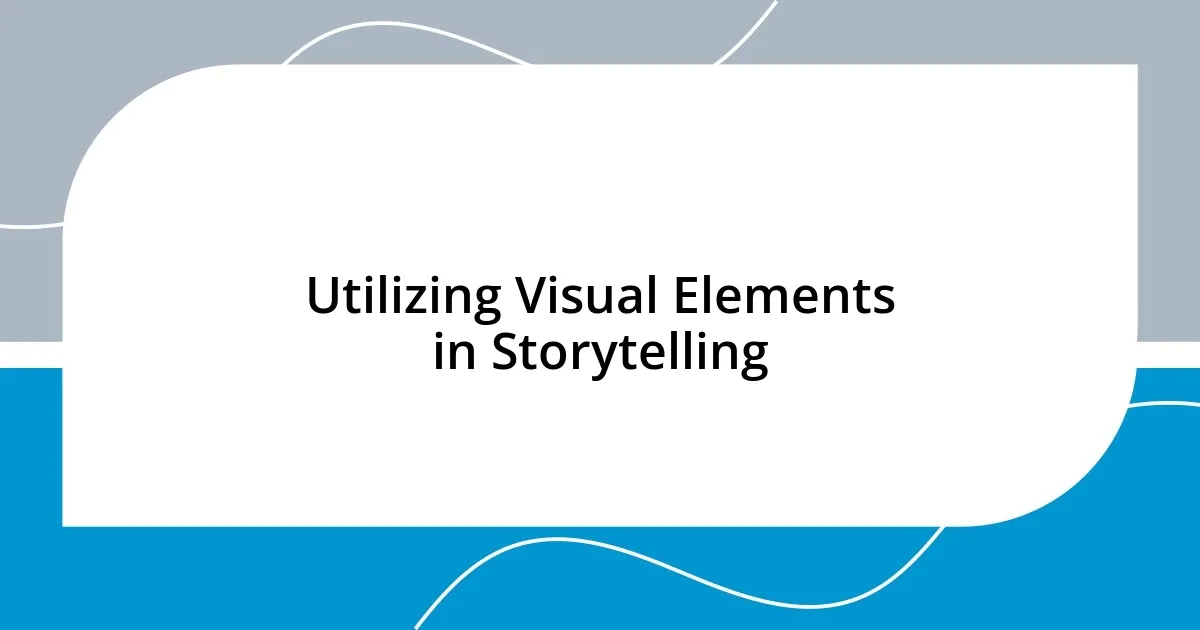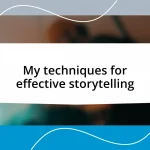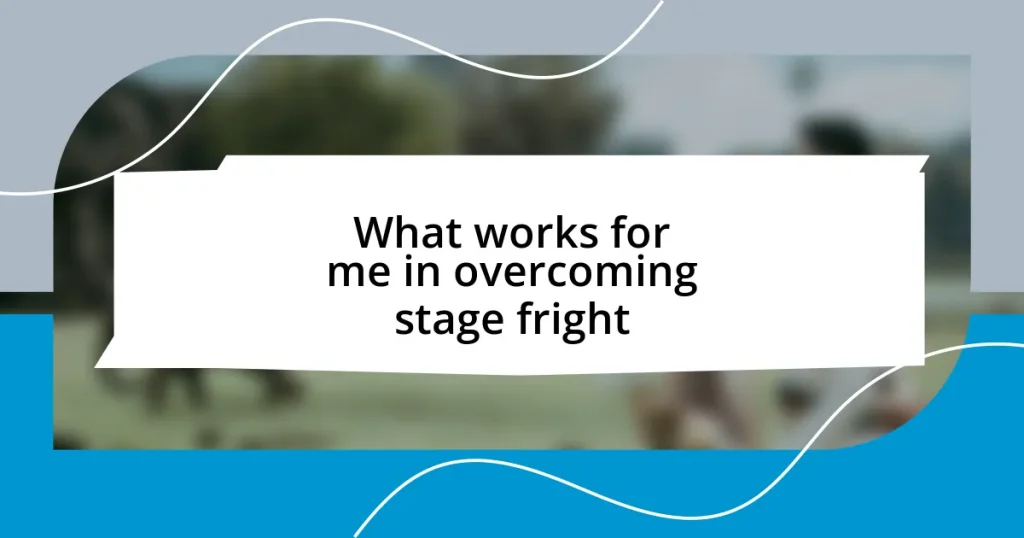Key takeaways:
- Storytelling creates emotional connections through relatable characters and structured narratives.
- Defining a core message provides clarity and focus, guiding the narrative effectively.
- Engaging the audience emotionally and utilizing visual elements can enhance their overall experience.
- Consistent practice, seeking feedback, and finding inspiration are vital for refining storytelling skills.

Understanding Storytelling Fundamentals
At its core, storytelling is about connection. I remember the first time I shared a personal story at a gathering. The room fell silent—it was as if everyone could feel my vulnerability. This moment taught me that stories resonate on an emotional level, creating bonds between the storyteller and the audience. Don’t you find it fascinating how a well-told story can stir feelings of joy, sadness, or even nostalgia?
Understanding the fundamentals of storytelling means recognizing the importance of structure. A captivating story typically has a beginning, middle, and end. Think of it like a journey: you start with an intriguing premise, build through challenges, and resolve with impactful conclusions. When I crafted a story about overcoming failure, structuring it with clear stages helped my audience follow along and engage deeply with my experiences.
Moreover, characters are the heart of any narrative. My favorite stories feature relatable characters that evoke empathy and connection. Do you recall your favorite book or movie? Those characters felt real, didn’t they? They pulled you into their world, making you care about their outcomes. I’ve learned that developing rich, multidimensional characters is crucial. It’s these figures that allow the audience to see themselves within the narrative, making the experience much more meaningful.

Identifying Your Story’s Core Message
Identifying your story’s core message is truly vital to crafting a narrative that resonates. I recall a project where I struggled to pinpoint what I wanted to say. It wasn’t until I asked myself, “What do I want the audience to feel or learn?” that everything clicked. This reflection helped me distill my message from a jumble of ideas into a single, powerful statement.
A concise core message acts like a compass, guiding the narrative and keeping it focused. During my early attempts at storytelling, I often meandered through my ideas, losing my audience along the way. Once I embraced the practice of defining my message before drafting, I noticed my stories became tighter and more engaging. Isn’t it intriguing how clarity in thought can lead to clarity in storytelling?
Your core message should stem from personal experiences and insights. For me, sharing a lesson learned from hardship not only connects with others but also empowers them. This notion is essential—what you convey through your story can inspire and influence your audience’s perceptions and actions. I’ve found that when my message is rooted in genuine emotion and authentic experiences, it resonates on deeper levels than I ever imagined.
| Story Element | Importance |
|---|---|
| Core Message | Guides narrative focus and clarity |
| Personal Experience | Enhances connection and relatability |
| Audience Emotion | Creates lasting impact and engagement |

Crafting Relatable Characters and Conflicts
Crafting relatable characters and conflicts is essential for impactful storytelling. When I reflect on my own writing, I remember a character I created based on a mixture of traits from people I know. This character faced dilemmas that mirrored real-life challenges, which made them instantly relatable. I noticed that audiences connect with characters that experience genuine struggles, fears, and triumphs—elements that remind them of their own lives.
To create compelling characters and conflicts, consider these key points:
- Authenticity: Infuse your characters with real emotions and flaws. Readers empathize with imperfections, making characters feel more human.
- Relatable Goals: Give your characters aspirations or conflicts that resonate universally—such as love, acceptance, or success.
- Dynamic Relationships: Develop complex interactions between characters. Their conflicts can reveal deeper layers of personality and foster audience investment.
- Personal Touch: Draw from your experiences or observations. When I share a character’s battle with self-doubt, it often reflects my own journey, which creates a deeper emotional bond.
- Conflict as Catalyst: Ensure that conflicts are not only present but also essential to character growth. The journey through conflict transforms your characters, inviting the audience to evolve alongside them.

Structuring Your Story for Impact
Structuring your story is crucial for leaving a lasting impression. I remember when I first experimented with different structures—like starting at the end and then looping back to the beginning. It was eye-opening to see how this approach can create suspense and keep readers hooked. Have you tried rearranging your story’s timeline?
In my experience, the classic three-act structure also works wonders. This method allows a natural flow: setup, confrontation, and resolution. When I employed this structure in one of my narratives, it felt like building a bridge that guided readers smoothly from excitement to the emotional payoff. The result? A story that lingered in the audience’s mind long after they finished reading.
Another technique I find effective is using cliffhangers at the end of pivotal sections. I recall crafting a scene that ended with a character facing a tough decision, leaving readers on the edge of their seats. It made them eager to turn the page, and I noticed they were more invested in the outcome. Isn’t it fascinating how a well-structured story can elevate the reader’s experience?

Engaging Your Audience Emotionally
Engaging your audience emotionally requires more than just crafting compelling narratives; it’s about tapping into the shared human experience. I recall writing a scene where a character faced a loss that mirrored my own—a moment that still sends chills down my spine. When I shared that character’s grief, I could almost feel the readers’ hearts echoing the pain. Have you ever felt the power of your words conjuring someone else’s memory? It’s in these moments that our stories become a shared journey.
To truly connect, I think it’s important to delve into vulnerability. When I reveal a character’s insecurities, like when they stumble over their words in a critical moment, it lights a fire of recognition in the audience. I’ve found that people often nod along while reading, as if to say, “I’ve been there too.” This connection can transform casual readers into invested fans, eager to see how these vulnerabilities will shape the character’s arc.
I also believe that co-creating emotional experiences with your audience can be transformative. I once wrote a climactic moment filled with unexpected joy and surprise, drawing on my own experiences of serendipity. Watching readers react with joy and then reflect on their own “aha” moments was amazing. It made me realize that engaging emotionally is not just about the character’s journey; it’s about holding a mirror to the audience’s life, prompting them to reflect, relate, and ultimately, resonate. Have you considered how your personal experiences can enrich your stories?

Utilizing Visual Elements in Storytelling
Using visual elements in storytelling can significantly enhance the reader’s experience. I vividly remember a time when I incorporated illustrations and images into a digital story I created. The visuals not only complemented the text—they transformed it, offering a deeper understanding of the characters and setting. Have you ever noticed how a well-placed image can evoke emotions that words alone might struggle to convey?
In my experience, incorporating color schemes can also elevate storytelling. For instance, while designing a promotional poster for a community event, I chose warmer tones to evoke feelings of joy and excitement. The response was overwhelmingly positive, with attendees commenting on how the colors captured the spirit of the gathering. Isn’t it intriguing how a simple color choice can influence perception and mood?
Another technique I’ve found rewarding is using visual metaphors. I once depicted a character’s internal struggle with a stormy sky gradually clearing as they made pivotal decisions. It added layers to the narrative, allowing readers to visualize the transformation. This approach not only kept the audience engaged but made the theme of resilience resonate on a deeper level. Have you thought about how visuals could amplify your storytelling and create memorable connections?

Refining Your Storytelling Skills Consistently
Refining your storytelling skills is an ongoing journey that thrives on practice and exploration. Personally, I make it a routine to write daily, even if it’s just a few paragraphs. This consistent practice not only sharpens my skills but also uncovers new ideas I would have otherwise overlooked. Have you carved out time in your day to simply write? I promise, those moments often lead to surprising breakthroughs.
Another effective method I’ve embraced is seeking feedback. I regularly share drafts with trusted friends or fellow writers, inviting their perspectives. For me, the insights they offer are invaluable, helping me see my work through fresh eyes. I recently received feedback on a character arc that I thought was complete, only to discover areas for growth. Has someone ever pointed out something in your work that made you rethink your approach? I find that each critique nudges my storytelling to evolve, making it stronger and more impactful.
Lastly, I’m always on the lookout for inspiration. When I consume stories—be it in books, films, or podcasts—I pay attention to what captivates me and why. I once watched a movie whose plot twist left me breathless, prompting me to analyze how it was executed. That moment inspired me to experiment with pacing and suspense in my own writing. What about you? When was the last time a story moved you deeply, and how can you apply that experience to your craft? Embracing these insights can enrich your storytelling and keep your skills fresh.














